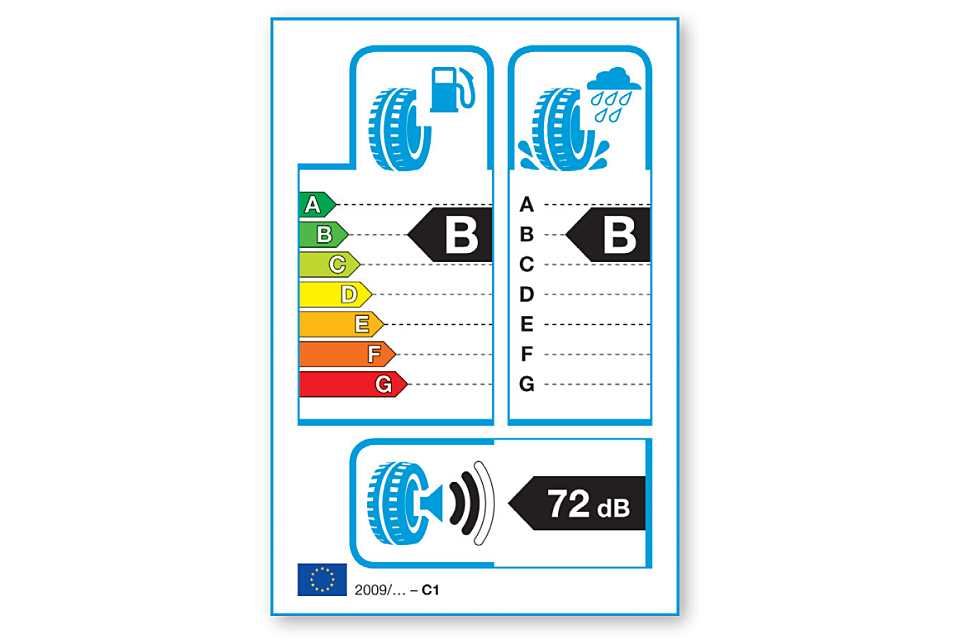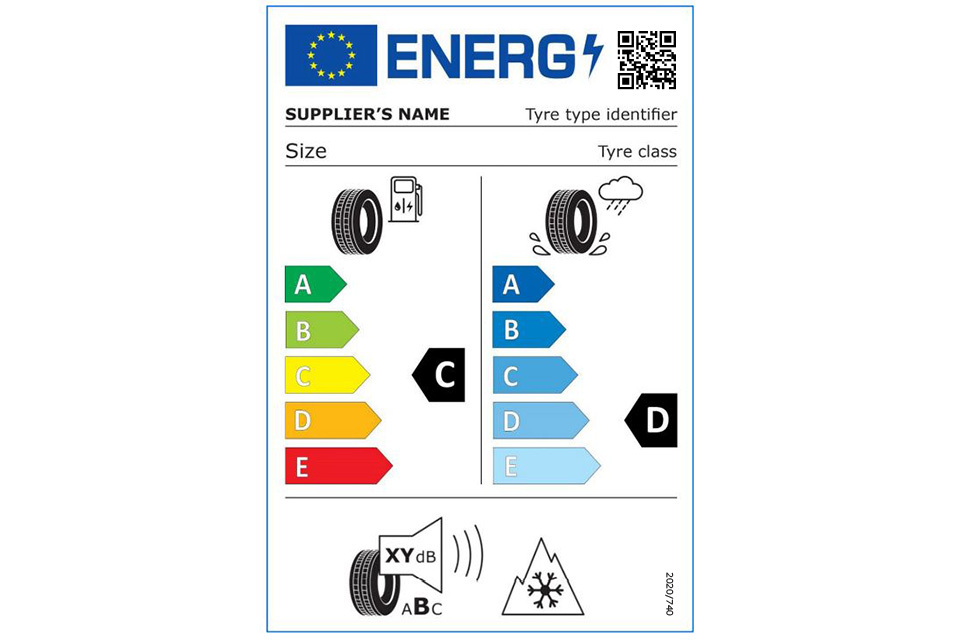Supply or distribute vehicle tyres: labelling rules
Rules about the labels that tyres must display to give information about fuel efficiency, wet grip and noise classification.
Tyres sold on the UK market must have labels that give information about:
- fuel consumption
- wet grip
- noise classification
What tyres the rules apply to
This applies to tyres for:
- cars
- vans
- heavy trucks
Exemptions
The rules do not cover:
- secondhand
- retreaded tyres
- professional off-road tyres
- temporary-use spare tyres
- studded tyres
- tyres used only for racing
- tyres whose speed rating is less than 80 km/h
- tyres to be fitted only on vehicles registered for the first time before 1 October 1990
- tyres whose nominal diameter is smaller than 254 mm or bigger than 635 mm
- tyres produced before 1 July 2012 for which grading/labelling was not performed
How the label system works
In Great Britain, the label classifies tyres from A (the highest performing) to G (the lowest performing).

Example of tyre label showing B rating for fuel efficiency, B rating for wet grip, 72 decibels for noise rating
In Northern Ireland, the label classifies tyres:
- from A (the highest performing) to E (the lowest performing) for fuel efficiency and wet grip
- from A (the highest performing) to C (the lowest performing) for external noise

Example of a tyre label in Northern Ireland
What the label must display
The label must display the:
- fuel efficiency associated to the tyre’s rolling resistance
- tyre’s external noise level (shown in decibels) - not any tyre noise heard inside the vehicle
- the impact on vehicle safety associated to the tyre’s wet grip
- supplier’s name, model name, size and tyre class - Northern Ireland only
- suitability for use on snow or ice - Northern Ireland only
Fuel efficiency
Reducing the rolling resistance of a tyre reduces the amount of fuel a vehicle consumes less fuel.
Work out the fuel efficiency for the tyre label by:
- following the process in annex I of the regulation
- measuring it in accordance with the United Nations Economic Commission for Europe (UNECE) Regulation No. 117 (PDF 2MB) and its subsequent amendments
Wet grip
Wet grip is an important safety characteristic of a tyres as it improves the braking distance of a vehicle .
Work out the wet grip values for the tyre label using the relevant regulations.
Noise rating
The tyre label provides information about the noise the tyres generate outside the car, this is called ‘rolling noise’.
The lower the rolling noise, the lower the impact your vehicle will have on overall environmental noise levels.
The tyre’s external noise level will be shown in decibels. In Northern Ireland, the label also classifies the noise rating from A (the highest performing) to C (the lowest performing).
Tyre class
Tyres are classified as:
- C1 (passenger cars, vans and small trailers)
- C2 and C3 (heavy goods vehicles, buses, coaches and heavy trailers)
Article 8 of EU regulation 661/2009 sets out how tyres should be classified.
What to do when you supply or distribute tyres
What you need to do depends on:
- whether you supply or distribute tyres
- where you supply or distribute tyres
Tyre suppliers (manufacturers or importers)
Supplying tyres in Great Britain
If you supply tyres in Great Britain, you must:
- either put a sticker on the tyre tread or a label on each delivery of tyres to the dealer and end-user for passenger (car) and light commercial vehicle tyres
- provide technical literature (leaflets, brochures and so on), including on your website for passenger, light commercial vehicles, and truck/bus tyres
Supplying tyres in Northern Ireland
If you supply tyres in Northern Ireland, you must:
- put a sticker on the tyre tread and provide a product information sheet - for a batch of identical tyres, you can provide a printed label and product information sheet for the whole batch
- display the tyre label and make the product information sheet available to be downloaded or printed on any website selling the tyres
- display the tyre label on any advertisements or technical literature such as leaflets or brochures
Tyre distributors
Distributing tyres in Great Britain
If you distribute tyres in Great Britain you must:
- make sure that, at the point of sale, tyres have the sticker or have a label for the customer to see before buying the tyre
- give the information on the fuel efficiency, wet grip (where applicable) and external noise during the buying process if the tyres offered for sale are not visible to the customer (for passenger and light commercial vehicles tyres)
- give information on or with the bill (for passenger car, light commercial vehicles and truck/bus tyres)
Distributing tyres in Northern Ireland
If you distribute tyres in Northern Ireland you must:
- make sure that, at the point of sale, tyres have the sticker - for a batch of identical tyres, you can display a label next to the tyres
- provide a product information sheet for each tyre (or batch of tyres) - you must provide a printed version if asked for it
- give the information from the tyre label to your customers if they cannot see the tyres before buying, for example, if you’re selling tyres over the phone
- display the tyre label and make the product information sheet available to be downloaded or printed on any website selling the tyres
- display the tyre label on any advertisements or technical literature such as leaflets or brochures
Vehicle suppliers and distributors
If you supply and distribute vehicles in the EU or UK you must provide end-users with information on the fuel efficiency, wet grip (where applicable) and external noise of the tyre that are offered before the sale of the vehicle.
Report a tyre supplier or distributor to DVSA
You can report a supplier, dealer or private seller to DVSA if you think they are not following tyre labelling rules.
More information
Visit the Tyre Industry Federation website for more guidance.
Visit the European Commission website for more information about the labelling of tyres.
These regulations have more detailed information about the rules:
- Regulation No 1222/2009 (the Labelling of Tyres with respect to Fuel Efficiency and other Essential Parameters)
- Regulation 228/2011 (with regard to the wet grip testing method for C1 tyres)
- Regulation 1235/2011 (with regard to the wet grip grading of tyres, the measurement of rolling resistance and the verification procedure)
- Regulation No 740/2020 (on the labelling of tyres with respect to fuel efficiency and other parameters, amending Regulation (EU) 2017/1369 and repealing Regulation (EC) No 1222/2009)
Updates to this page
-
Added: - second hand tyres to the list of exemptions - information for suppliers in Northern Ireland
-
First published.